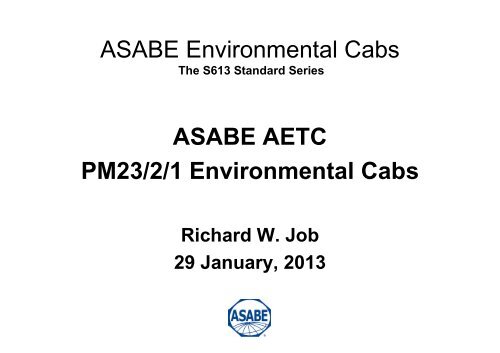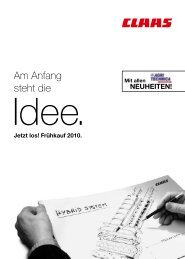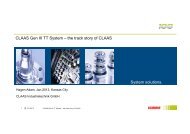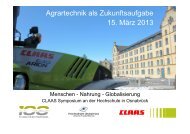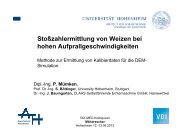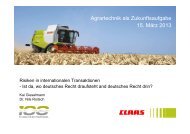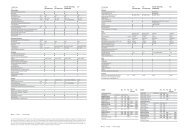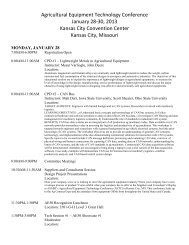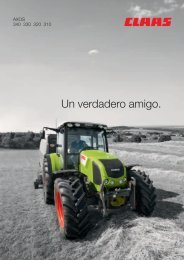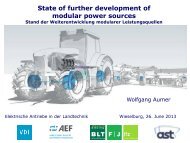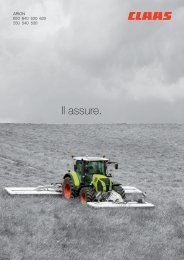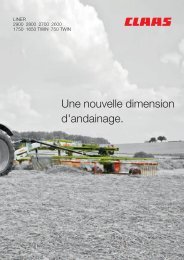06.3 Richard Job Air Quality Systems for Agricultural Cabs
06.3 Richard Job Air Quality Systems for Agricultural Cabs
06.3 Richard Job Air Quality Systems for Agricultural Cabs
You also want an ePaper? Increase the reach of your titles
YUMPU automatically turns print PDFs into web optimized ePapers that Google loves.
ASABE Environmental <strong>Cabs</strong><br />
The S613 Standard Series<br />
ASABE AETC<br />
PM23/2/1 Environmental <strong>Cabs</strong><br />
<strong>Richard</strong> W. <strong>Job</strong><br />
29 January, 2013
ASABE Environmental <strong>Cabs</strong><br />
The S613 Standard Series<br />
• Some history:<br />
– I was assigned the task of joining the ASAE<br />
Environmental <strong>Cabs</strong> committee in 1995. They<br />
were working on a new standard which could<br />
be used to qualify a cabs to protect the<br />
operator in spraying applications
ASABE Environmental <strong>Cabs</strong><br />
The S613 Standard Series<br />
• Who were the members of the committee<br />
– Equipment manufacturers<br />
– Component manufacturers<br />
– Filter manufacturers<br />
– NIOSH researchers<br />
• The Miller Nelson Study of filtration systems<br />
and potential application to cabs had just<br />
been completed
ASABE Environmental <strong>Cabs</strong><br />
The S613 Standard Series<br />
– What are the issues involved in protecting the<br />
operator:<br />
• Hazard types<br />
• State of the industry generally<br />
• Level of protection offered in current cab design<br />
• Filter design to provide adequate protection to the<br />
operator<br />
• How to measure contaminants?<br />
• How to verify a system design?<br />
• What instrumentation was available – cost?<br />
– How could it be effectively used?
ASABE Environmental <strong>Cabs</strong><br />
The S613 Standard Series<br />
– What level of protection should the operator<br />
be af<strong>for</strong>ded?<br />
• In particulate environments?<br />
• In vapor environments?<br />
• What about fumigants?<br />
– How does a vapor hazard compare to a<br />
particulate hazard?<br />
– Is there equipment which can measure how<br />
well constructed a system design is?<br />
– What role should protection against fumigants<br />
play in this standard?
ASABE Environmental <strong>Cabs</strong><br />
The S613 Standard Series<br />
• Results of these deliberations resulted in<br />
ASAE S525 <strong>Agricultural</strong> <strong>Cabs</strong> –<br />
Engineering Control of Environmental<br />
<strong>Air</strong> <strong>Quality</strong>. Approved in 1997 as an<br />
ANSI standard<br />
– It gave us a measurable means to determine<br />
a protection level <strong>for</strong> the operator<br />
– It categorized cabs into three categories<br />
• BC – a basic cab<br />
• ECPAD - enclosed cab <strong>for</strong> pesticide application<br />
incorporating dermal hazard reduction
ASABE Environmental <strong>Cabs</strong><br />
The S613 Standard Series<br />
• ECPAR - enclosed cab <strong>for</strong> pesticide application<br />
incorporating respiratory hazard reduction<br />
• The qualification test proved to be difficult<br />
to per<strong>for</strong>m because the amount of<br />
contaminant in the atmosphere was not<br />
consistent
ASABE Environmental <strong>Cabs</strong><br />
The S613 Standard Series<br />
• One year after it’s introduction researchers<br />
identified a series of tractor cabs that were<br />
certified to the standard failed to comply<br />
with the standard<br />
– Detailed analysis of the reason <strong>for</strong> failure<br />
were that the manufacturing processes were<br />
not consistent resulting in poor fit of some<br />
sealing surfaces which leaked - adequate<br />
design??
ASABE Environmental <strong>Cabs</strong><br />
The S613 Standard Series<br />
• The ultrasonic scanning procedure<br />
recommended as part of the standard was found<br />
to not provide consistent results
ASABE Environmental <strong>Cabs</strong><br />
The S613 Standard Series<br />
• We quickly changed S525, eliminating the<br />
ultrasonic scanning procedure and<br />
changing the scope to reflect that the<br />
standard is to be applied in a managed<br />
program of “occupational health and<br />
safety”.<br />
• The change was approved as an ANSI<br />
standard in 2003
ASABE Environmental <strong>Cabs</strong><br />
The S613 Standard Series<br />
• During this and a subsequent period we<br />
attempted to introduce ASAE S525 into<br />
the ISO standards arena. Twice it was<br />
started and then withdrawn because there<br />
were, or were perceived problems with the<br />
standard as it was being developed.<br />
• Much discussion took place on the role of<br />
designing a cab <strong>for</strong> spraying applications,<br />
maintenance and testing in the managed<br />
program.
ASABE Environmental <strong>Cabs</strong><br />
The S613 Standard Series<br />
• For the next few years the committee had<br />
difficulty determining how to move <strong>for</strong>ward<br />
with what a meaningful environmental cab<br />
standard should be.<br />
• In 2007 the committee in its annual<br />
meeting concentrated on what a cab<br />
standard should achieve.
ASABE Environmental <strong>Cabs</strong><br />
The S613 Standard Series<br />
• They went back to the Hierarchy of<br />
Controls as defined in ANSI/AIHA Z10,<br />
“the organization shall implement and<br />
maintain a process <strong>for</strong> achieving feasible<br />
risk reduction based on the following order<br />
of controls:<br />
– A Elimination,<br />
– B Substitution of less hazardous materials,<br />
processes, operations or equipment,
ASABE Environmental <strong>Cabs</strong><br />
The S613 Standard Series<br />
– C. Engineering controls<br />
– D. Warnings<br />
– E. Administrative controls; and<br />
– F. Personal protective equipment (PPE)
ASABE Environmental <strong>Cabs</strong><br />
The S613 Standard Series<br />
• ANSI/AIHA Z10 talks about:<br />
– The nature of the risk<br />
– The risk reduction desired<br />
– The best practices of industry<br />
– Available technology<br />
– Cost effectiveness
ASABE Environmental <strong>Cabs</strong><br />
The S613 Standard Series<br />
• Based on the rating that an engineering<br />
control is preferable to personal protective<br />
equipment they applied the OSHA<br />
requirements from a “Managed Program of<br />
Occupational Health and Safety? These<br />
are:<br />
– Identification of the risk involved and the<br />
protection required <strong>for</strong> the hazard identified<br />
– A survey of the equipment involved in the<br />
hazardous application
ASABE Environmental <strong>Cabs</strong><br />
The S613 Standard Series<br />
– Testing the protection equipment to assure it<br />
provides the protection required <strong>for</strong> the<br />
identified hazard<br />
– Repair and/or replacement of any defects or<br />
defective equipment found<br />
– Retesting of the equipment system as<br />
required<br />
– Recording in an appropriate log book all<br />
in<strong>for</strong>mation regarding the repairs, test results<br />
and replacement of parts and/or components
ASABE Environmental <strong>Cabs</strong><br />
The S613 Standard Series<br />
• Based on this concept they proposed to<br />
develop a standard that could consist of 6<br />
parts:<br />
– I. Introduction<br />
• Scope and Limitations<br />
• Definitions<br />
• Context of this standard within a managed<br />
program
ASABE Environmental <strong>Cabs</strong><br />
The S613 Standard Series<br />
– II. Design Standard <strong>for</strong> <strong>Cabs</strong><br />
– III. Design Standard <strong>for</strong> Cab Filters<br />
– IV. Cab Manufacture <strong>Quality</strong> Tests<br />
– V. Cab Filter Manufacture <strong>Quality</strong> Tests<br />
– VI. Field Certification of Cab <strong>Air</strong> <strong>Quality</strong><br />
• “Parts VI and beyond are future work that<br />
will likely be developed over the long term”
ASABE Environmental <strong>Cabs</strong><br />
The S613 Standard Series<br />
• “ASABE S613-1 Tractors and selfpropelled<br />
machinery <strong>for</strong> agriculture—<br />
<strong>Air</strong> quality systems <strong>for</strong> cabs—<br />
Terminology and overview” was<br />
approved as an ANSI standard in<br />
February 2009
ASABE Environmental <strong>Cabs</strong><br />
The S613 Standard Series<br />
• “It covers terminology, definitions and an<br />
overview of how an environmental cab<br />
may be used in hazardous environments<br />
as part of an Occupational Health and<br />
Safety Management System”
ASABE Environmental <strong>Cabs</strong><br />
The S613 Standard Series<br />
• The Managed Program of Occupational<br />
Health and Safety listed in the standard<br />
comes directly from the OSHA<br />
requirements <strong>for</strong> industry<br />
• What does the standard define <strong>for</strong> a<br />
“Managed program” <strong>for</strong> spraying<br />
applications?<br />
– Identification of the risk involved and the<br />
protection required <strong>for</strong> the material to be<br />
applied in the spraying operation
ASABE Environmental <strong>Cabs</strong><br />
The S613 Standard Series<br />
– A survey of the machine and the cab involved<br />
in the spraying application. This includes:<br />
• Reviewing the cabin filtration system and the filter<br />
to assure the filter provides the reduction in<br />
contaminate level required … and<br />
• Identifying how long the filter can be used in this<br />
spraying application<br />
– Testing the cabin air system to assure it<br />
provides the protection required <strong>for</strong> the<br />
material to be applied. This also includes a<br />
review of any monitoring equipment to assure<br />
it is working properly.
ASABE Environmental <strong>Cabs</strong><br />
The S613 Standard Series<br />
– Repair and/or replacement of any defects or<br />
defective equipment found<br />
– Retesting of the cab air system if required<br />
– Recording in an appropriate log book all<br />
in<strong>for</strong>mation regarding the test results, and<br />
repairs and replacement of parts and/or<br />
components<br />
• We have replicated the procedure OSHA<br />
requires industry to follow <strong>for</strong> workers in a<br />
hazardous environment
ASABE Environmental <strong>Cabs</strong><br />
The S613 Standard Series<br />
• S613-2 Tractors and self-propelled<br />
machinery <strong>for</strong> agriculture—<strong>Air</strong> quality<br />
systems <strong>for</strong> cabs—Part 2: Cab & HVAC<br />
design was approved as an ANSI<br />
standard in November 2010<br />
• It defines the elements to consider in the<br />
design of a cab <strong>for</strong> environmental<br />
protection applications
ASABE Environmental <strong>Cabs</strong><br />
The S613 Standard Series<br />
• Some of these elements are:<br />
– Type of <strong>Air</strong>borne Contaminants<br />
• The cab filtration system design should consider<br />
the particular types of airborne contaminates that<br />
the tractor or self-propelled machinery will be<br />
typically operating in such as soil preparation,<br />
pesticide spraying, harvesting, etc.<br />
– Sources of <strong>Air</strong>borne Contaminants<br />
• The cab filtration system design should consider<br />
several filtration alternatives <strong>for</strong> the various<br />
operational solid, liquid, and/or gas contaminants.
ASABE Environmental <strong>Cabs</strong><br />
The S613 Standard Series<br />
– Cab as a Physical Barrier<br />
• The cab enclosure provides a physical barrier<br />
around the operator and a controlled environment<br />
inside the cab.<br />
– Per<strong>for</strong>mance Monitoring<br />
– System Operation and Maintenance<br />
– Cleaning and Maintenance<br />
• What we have tried to include are<br />
considerations the designer shall<br />
exercise in executing the design of a<br />
cab
ASABE Environmental <strong>Cabs</strong><br />
The S613 Standard Series<br />
• X613-3 Tractors and self-propelled<br />
machinery <strong>for</strong> agriculture—<strong>Air</strong> quality<br />
systems <strong>for</strong> cabs—Part 3: Filters <strong>for</strong><br />
environmental cab HVAC systems is<br />
currently undergoing a second round<br />
of balloting within the committee <strong>for</strong><br />
approval as a national standard<br />
– We have determined that this standard will<br />
cover the design, testing and field approval of<br />
the filters
ASABE Environmental <strong>Cabs</strong><br />
The S613 Standard Series<br />
• Note that we have now eliminated items IV<br />
and V:<br />
– IV. Cab Manufacture <strong>Quality</strong> Tests<br />
– V. Cab Filter Manufacture <strong>Quality</strong> Tests<br />
from the original objectives of the committee <strong>for</strong><br />
this standard as the manufacturers are in the<br />
best position to determine the tests needed to<br />
verify the quality of their product
ASABE Environmental <strong>Cabs</strong><br />
The S613 Standard Series<br />
• X613-4 Tractors and self-propelled<br />
machinery <strong>for</strong> agriculture—<strong>Air</strong> quality<br />
systems <strong>for</strong> cabs—Part 4 Test procedure<br />
<strong>for</strong> qualifying a cab in the field is being<br />
balloted via a PPF to PM03 <strong>for</strong> work to<br />
begin.
ASABE Environmental <strong>Cabs</strong><br />
The S613 Standard Series<br />
• The preliminary draft calls <strong>for</strong>:<br />
– First, determine what the level of protection<br />
will be required <strong>for</strong> the application.<br />
– Do a survey/test of how well the cab is able to<br />
protect the operator within these<br />
requirements.<br />
– Repair and/or replacement of elements in the<br />
cab would be as specified by the<br />
manufacturer.
ASABE Environmental <strong>Cabs</strong><br />
The S613 Standard Series<br />
• We will be discussing how to proceed with<br />
this standard at a special committee<br />
meeting this afternoon
ASABE Environmental <strong>Cabs</strong><br />
The S613 Standard Series<br />
• Future elements to consider as potential<br />
parts of this standard:<br />
– Training of operators <strong>for</strong> hazardous<br />
applications<br />
– Is there a need <strong>for</strong> improved safety labeling of<br />
these cabs?<br />
– Is a generic safety manual needed?<br />
• When these items are resolved we will ask<br />
or be asked if there are other items or<br />
elements we should be looking at
ASABE Environmental <strong>Cabs</strong><br />
The S613 Standard Series<br />
Questions?<br />
Thank You!


